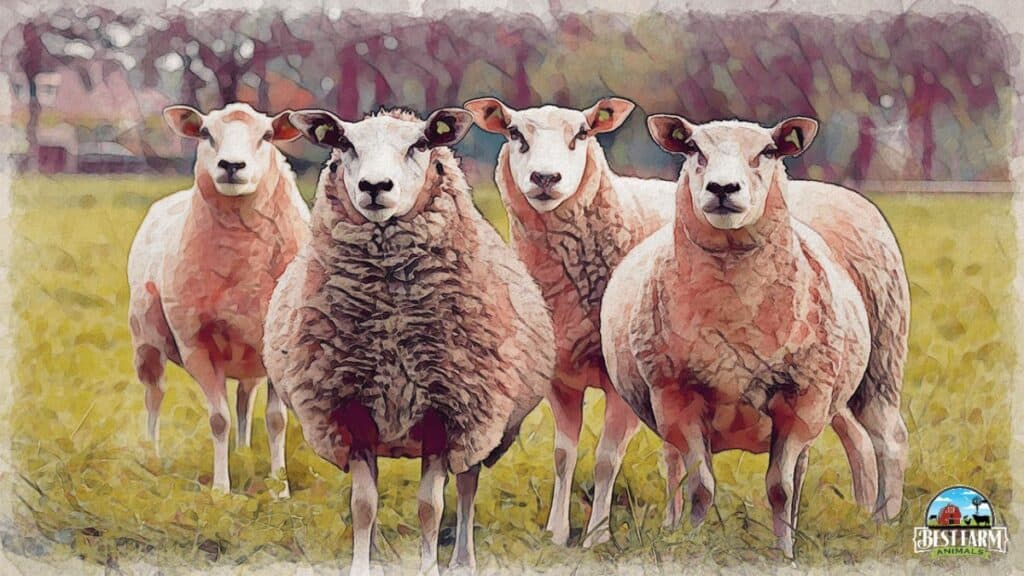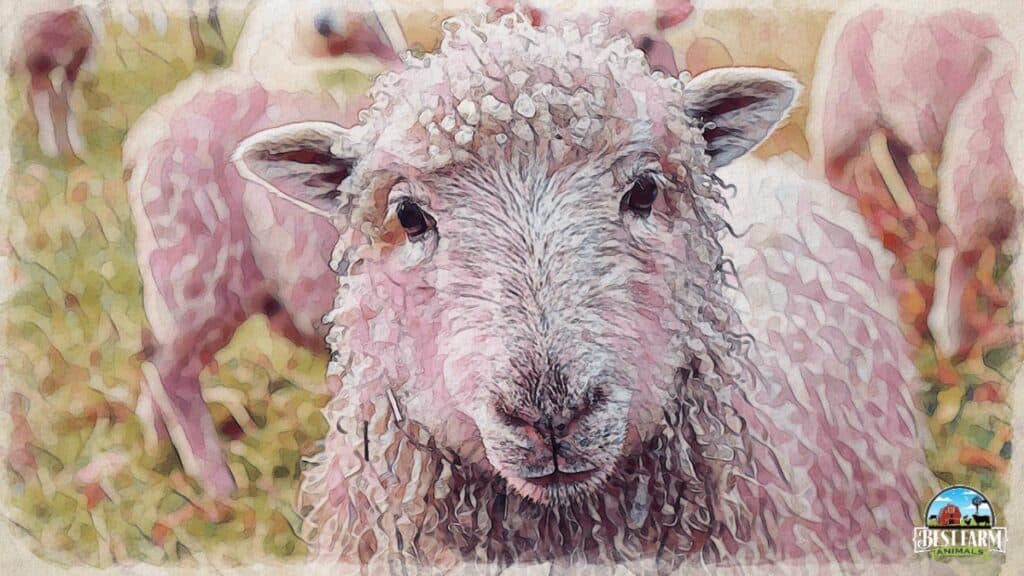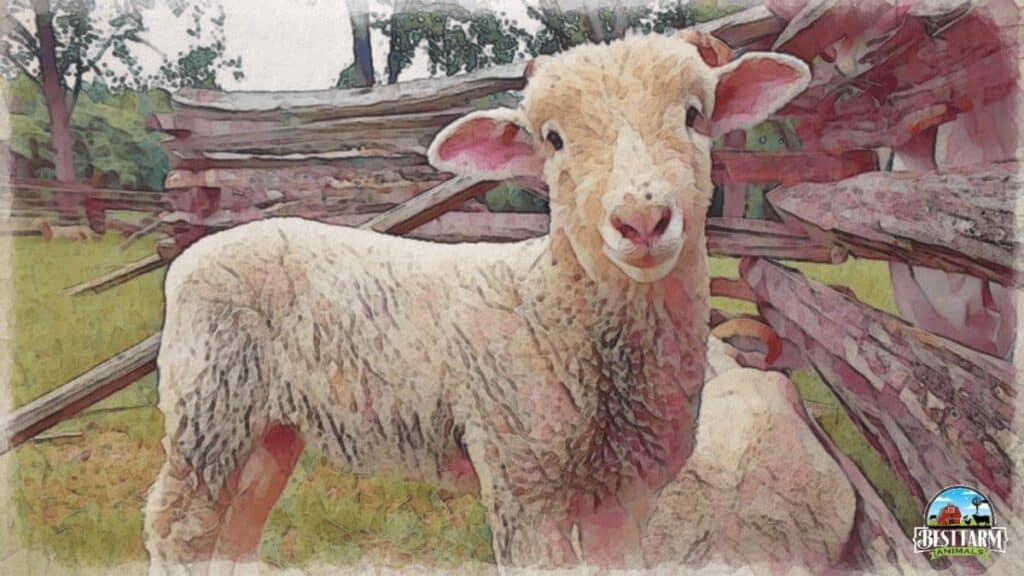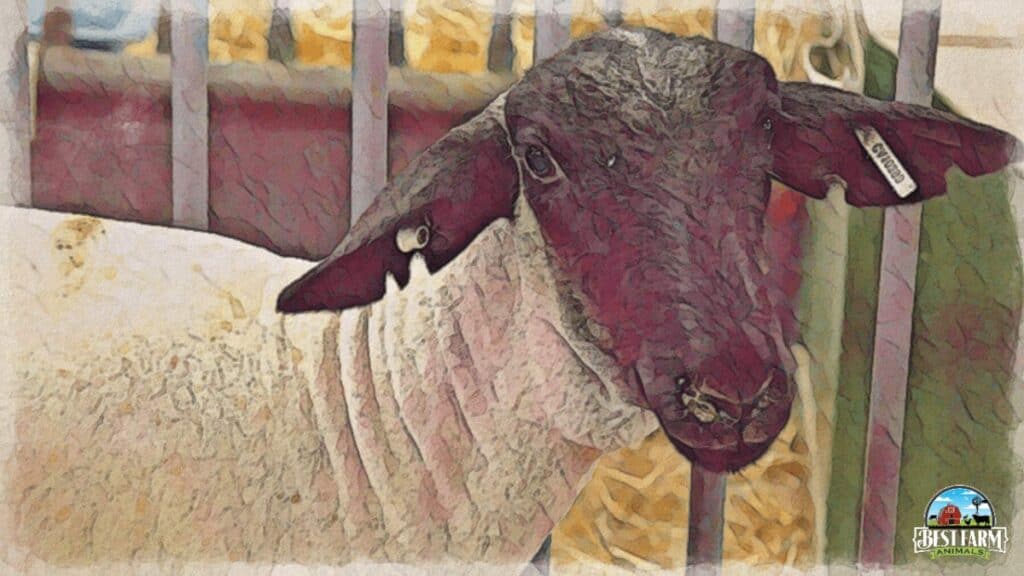If you ask my kids if they like raising sheep, my #2 daughter will say she likes sheep much better than goats because they are easier to tame. My #1 daughter says she likes sheep better for 4H because they listen to you in the ring, but she likes goats better as pets because they have more personality and stay tame.
Sheep tend to “forget” who you are at home but become your best friend in an unfamiliar place (like the county fair).
Is it hard raising sheep? Sheep are easier to raise compared to other domestic animals. They don’t require much space and are generally hardy. Additionally, they are docile and can thrive in most regions. As a beginner, you can benefit from raising sheep on a medium scale and growing gradually to a large scale.
You may expect returns from the third year onwards. Raising sheep is quite profitable once you get a market for wool, milk, or meat. Choose the right breed for your region.
Sheep are popular to raise. They are generally gentle, easy animals and are well-adapted to outdoor conditions. Sheep can be raised through grazing, which makes their food costs low to non-existent. They have multiple uses and are raised for a variety of reasons. Let’s discuss what you need to know to raise sheep.

How to Raise Sheep: (10 Steps to Take Before Bringing A Lamb Home)
To raise a sheep, you need a pasture land or space where they can eat hay or grass. Putting a fence or a shelter for your sheep is also a good way to keep them safe. Don’t forget to provide water as well. Below are other steps to take before raising a sheep.
1. Decide the End Goal Of Raising Sheep
There are many reasons that sheep are growing in popularity. They are mild-mannered, calm, and mellow. This makes them a great project to teach kids responsibility and it makes them a good pet. Sheep produce many by-products, including meat, wool, and milk.
Raise Sheep for Meat
Homesteaders and small-scale farmers may find success and fulfillment in raising meat sheep. Because they are bred and raised specifically for their capacity to produce meat, meat sheep are typically larger and more powerful than wool-producing sheep breeds.
Sheep meat commands a high price. Rams or yearlings are frequently sold as meat by sheep farmers. More than others, some sheep breeds are better suited for use as meat sheep.
- Katahdin
- Dorper
- Suffolk
- Texel
Raise Sheep For Wool
Raising sheep is a rewarding which is why it’s grown in popularity in recent years. The demand for wool and wool-based products is anticipated to increase in the future due to the rising popularity of crafts like felting, spinning, and knitting.
Wool from sheep comes in a variety of types. Some farmers breed special kinds of sheep and produce expensive wool. Other farmers market their wool for use in making textiles or other goods, like carpets.
- Merino
- Corriedale
- Romney
- Bluefaced Leicester

Raising Sheep For Milk
Many cultures around the world consider sheep milk to be a delicacy. Sheeps’ milk is becoming more and more well-liked thanks to its unique flavor and nutritional benefits. Sheep milk is easier to digest than cow milk and contains more protein and calcium.
Compared to goat or cow milk, sheep milk has a much higher fat content. Because it makes more cheese per volume than other types of milk, this makes it perfect for making cheese.
There isn’t really a specific “milk sheep breed,” but a variety of sheep breeds are used to make milk.
- East Friesian
- Lacaune
- Awassi
Raising Sheep for Profit
Not all sheep farmers are in it for the money. Some homesteaders want to feed their families high-quality lamb meat and control what goes into their food. Raising sheep allows you to give your family access to cheaper, healthier meat without sacrificing taste. Many homesteaders decide to raise sheep for meat, but they later learn to love knitting, spinning wool, and the rich flavor of sheep milk.
Sheep have a smaller profit margin than some other farm animals. To increase profits and cover fixed costs of sheep ownership, hundreds of sheep are frequently required. But many homesteaders take measures to offset the cost of their family’s sheep.
- Renting sheep our to mow grass and keep wild areas neat
- Selling lambs to other farmers or to 4H kids
- Selling Ram services
- Selling Wool
- Learn how to butcher lambs (local services are strained as larger butchering shops have been acquired and shut down across the country- making it difficult for small farmers to get an animal processed.)
- Selling Wool Products
- As part of a hobby farm
Raise A Sheep as a Pet
Many people find enjoyment in raising a lamb as a pet. Lambs are very sociable and have a strong capacity for love (though they do require a lot of daily, quality time to truly bond with people). Lambs have long been cherished as a child’s pet, and in recent years, they have gained popularity as indoor pets. Once trust has been established, they are kind and follow a child.
They have a long-term memory for specific human faces and can recognize them. They will bond to their human owners and love to hear their voices. They can be taught to follow various commands. Rams can become aggressive, making them a bad pet. Even so, sheep have emotional recognition and reactivity.
They make a great animal to teach kids responsibility.
Sheep for Self-Sufficiency
Not all sheep farmers are in it for the money. My friend raises sheep because grass-fed sheep is so costly and she wants to know exactly what goes into the meat her family eats. Some people desire affordable access to high-quality milk, wool, and lamb meat for their families. The most effective way to achieve this goal is to raise sheep.

2. Choose The Type Of Sheep You Want
Sheep varieties are broken down into many categories:
- Hair sheep and wool
- Fine wool and carpet wool sheep
- Milk sheep and meat sheep
- Purebreds and crossbreds
- Highly reproductive sheep and less-reproductive sheep.
Choosing the right type of sheep can be overwhelming. Instead of becoming overwhelmed with all the different choices. If you are just getting started, then start with the basics. First, do you want to shear your sheep annually?
If you choose a wool sheep, you will need to sheer your sheep every year. That isn’t too hard, but it will take time to learn and will take time each year. A hair sheep shed on its own and doesn’t need shearing.
Secondly, decide if you want milk, meat, or wool sheep? It is often possible to have sheep with two focus products. You might be able to get wool and milk. Or meat and milk. Choosing your primary purpose will help you to determine what breeds to focus on.
If you choose wool as your main purpose, you might want to focus on a premium wool sheep. But, if you choose milk or meat, then you can choose a sheep that is ideal for those products and then decide if you also want wool.
Third, decide if you want to sell your lambs and ewes at a premium. This makes a difference in whether you want to purchase a purebred or registered sheep.
If you are a new sheep raiser, it is probably better to become more experienced and educated in raising sheep before purchasing purebred sheep. Losing purebred sheep to issues caused by inexperience can be very expensive.
Questions To Determine What Kind Of Sheep To Raise:
- Do you want to shear your sheep annually
- Do you want milk, meat, or wool production as a primary product?
- Do you want wool or hair sheep?
- Do you want to sell live sheep at a premium?

| Wool: Long & Fine | Meat: Wool & Hair | Milk |
| Leicesters – Long | Corriedale – Wool Large | Awassi – shaggy wool |
| Coopworth – Long | Dorset – Wool Medium | East Friesian – more difficult |
| Cotswold – Long | Polypay – Wool Many lambs | Lacaune – great for cheese |
| Lincoln – Long | Columbia – Wool Large breed | |
| Perendale – Long | Hampshire – Hair Large breed | |
| Merino – Short | Katahdin – Hair Low maintenance | |
| Debouillet – Short | Romney – Hair | |
| American Cormo – Short | Suffolk – Hair Most popular in the U.S. |
3. Know How Much Land Sheep Need
Generally, 4-5 sheep can fit on an acre of land. In some cases, as many as 10 sheep can fit on land with good healthy grass for grazing. That’s between 0.20 and 0.40 acres of land per 1-2 sheep.
The exact number depends on the type of grass and how healthy and hearty it is. If you have strong grass that is kept up and watered frequently, then you can fit more sheep on an acre. If you have pasture or natural grass, then it is better to opt for 5 sheep in an acre.
| City Lot | Country Pasture | |
| 0.20 – 0.40 Acres | 1 Lamb. Supply additional feed | 1 Lamb |
| 0.50 – 0.60 Acres | 2 Lambs | 3-4 Lambs if all pasture grass |
| 0.75 -1.0 Acres | 3 Lambs | 5-7 Lambs |
Generally, city lots can support fewer lambs than a country pasture. Part of this is due to restrictions usually found in cities. It is also because often a city lot includes other things such as sidewalks, houses, and other structures that don’t benefit the lamb.
Sheep need much less land than other animals such as cows or pigs, which makes them a great option for many urban homesteaders.
If you aren’t planning to grass-feed your sheep, then you can keep sheep in smaller areas. You will need to supply their food, but they will be happy with less space. An ewe needs 12-16 square feet of space in a pet. The following space requirements are recommended in a penned setting:
| Number and Type of Sheep | Space Needed Per Sheep For Good Health |
| Ewe | 12-16 sq feet |
| Lambing ewe | 16-25 sq feet |
| Ewe and lambs | 16-20 sq feet |
| Feeder Lambs | 8-10 sq feet |

4. Set Up Protection Fencing From Predators
Many predators can kill or maim your sheep. If you live in the city, these predators can be neighborhood dogs, coyotes, or other animals. In the country, you may see wolves, foxes, cougars, bobcats, or other animals. It will depend on where you live.
Take precautions before you purchase your sheep to make sure that they will be safe. There are two major steps that you can take to protect your sheep: build a fence to keep out predators and employ a guard animal.
Fencing should generally be at least 6-8 feet tall and have no larger than 6 in gaps in the fence. If foxes are a major predator in your area, you will need even closer fencing and should not have gaps more than 3 inches wide.
Most predators can climb or leap so high fences are much more effective than shorter fencing. Other predators will dig to gain access under the fence. You can prevent access by burying the fence at least 6-12 inches underground. Electric fencing is often used as a deterrent for predators. It doesn’t kill the predator but teaches them that they can’t enter a specific area.
Check out this article for more information on keeping sheep safe.
Guard animals are also used to protect sheep. Alpacas or llamas are very popular for this. They are not loud animals but make a great defense against a predator. Donkeys are also very protective of a sheep flock.
Dogs don’t tend to be a good guard animal because sheep are instinctively afraid of them and it can cause panic and stress in your flock.
You can also light your corrals to ward off predator attacks at night.
5. Set Up Appropriate Shelter For The Sheep
There is a debate about whether sheep need shelter or not. In their natural state, sheep seldom have regular shelter. Ironically, it is often more important to protect sheep from the sun and heat than it is to protect them from snow and freezing temperatures.
Otherwise, only lambing usually requires shelter. Newborn lambs cannot stand cold and wet climates and will die.
Sheep are highly adapted to cold and wet climates. It is more important for them to have adequate ventilation. If they don’t get fresh air, then they are likely to suffer from respiratory illnesses such as bronchitis or pneumonia. Respiratory ailments are a major concern of raising sheep.
Make sure that your sheep have adequate shade in the summer. It can be an open barn, windbreak, or a little hut. This is especially important in humid climates that make it even harder for sheep to cool down.
In the winter, sheep can be provided with shelter, but it should have adequate ventilation still. A cold ventilated place is much healthier for sheep than a warmer, humid area.
Lambs should have greater shelter and protection in the first few months of their lives. Most sheep will give birth in the late winter or early spring. If you are breeding sheep to birth in the middle of winter, you will need to be able to provide adequate shelter longer than if sheep birth in the springtime.

6. Set Up Bedding Needs Of Sheep
Sheep need bedding to stay warm and dry. It provides them with insulation. The most popular type of bedding used is straw. Other beddings also work well such as shredded paper, corn husks, wood shavings or chips, leaves, hemp, or peat.
Even sand is sometimes used to help ewes who suffer from mastitis. Each type of bedding absorbs moisture differently and must be changed out at different intervals.
Decide what type of bedding you will provide. If your sheep are mainly going to be raised outdoors, then you will probably want natural-looking bedding instead of paper products. Consider what bedding is available for you locally and the relevant costs.
When it is time to change out the bedding, consider adding it to compost. It makes great compost for your garden or for another farmer.
7. Buy A Good Quality Sheep
It’s important to purchase a healthy, quality sheep. You can either purchase one from a registered seller or choose a nice one from a local seller. If you choose to purchase locally, then check your extension office for the names of sellers. Ask other sheep owners where they have purchased from.
You can purchase sheep from a sale barn or auction, which will likely be cheaper. However, many unwanted or flawed sheep, called culls, are sold that way. That means that you will be purchasing a less desired sheep.
When purchasing a sheep, check out the flock of the sheep you are considering buying. That can tell you a lot about the health of the sheep. Ensure the farm is clean and the animals look healthy and happy.
How to check that a sheep is healthy
- Make sure the teeth align properly
- Eyes are bright and clear
- Sheep is alert and responsive with head held up
- Head and neck don’t have lumps
- No potbellies
- Check to make sure the sheep aren’t too fat or too thin
- Hooves should be properly trimmed

8. Feed And Water Your Sheep
Sheep require more protein than other animals. They are great grazers. If you have enough land, you can graze them. In the city, sheep will need about 70 feet x 70 feet of grass to graze. That’s per sheep!
Sheep can graze through 12 inches of snow. Additionally, they can usually meet their water needs by eating snow if the snow isn’t too crusty or hard to eat. But, it’s still a good idea to provide them water in case they can’t get enough water.
If you don’t have enough land to graze sheep, you must supplement their feed. Sheep will eat between 500-900 pounds of hay each year. Sheep feed usually has more protein in it than the feed for other animals. That’s because sheep need more protein.
You can give sheep treats to help train them. They love grain, peanuts or apples. Give treats as a reward for training them, not as a regular diet. Otherwise, sheep can get fat and unhealthy.
Sheep also need a mineral supplement. Don’t purchase mineral supplements with high amounts of copper in them. Copper can be toxic to sheep and they can’t stomach it as goats can. Purchase a supplement with only trace amounts of copper or no copper at all.
They also need salt to prevent bloating.
9. Shearing Should be Done 1-2 Times a Year
Wool sheep must be sheared one to two times a year. Regular wool sheep must be sheared in the spring or they will be miserable and unhealthy. Heavy wool sheep must be sheared twice a year.

10. Worming Sheep And Parasites
Sheep are susceptible to parasites and other bugs. If your sheep show signs of worms, then treat them immediately. Some sheep raisers worm sheep two or three times a year while others use natural methods to keep sheep healthy. Sheep that have more space are less likely to get worms or to get sick.
Rotate sheep among fields. They can also be fed dichotomous earth with their feed. It helps to kill the worms and keeps the sheep healthy.
Dichotomous earth also helps keep sheep free of parasites that can cling to them in their wool and skin. In much the same manner that chickens use dirt, you can rub Diatomaceous earth into their wool. Add it to their bedding to kill unwanted fleas, lice, and other parasites.
How many sheep should a beginner start with? Sheep are flock animals, so theysheep don’t like to be alone. SSo, you can start with at least two sheep to keep each other company. However, starting with four or five sheep as a beginner is recommended. YNote that the number of sheep you can keep depends on the size of land you have and the amount you are willing to invest. An acre of land can support three to five sheep comfortably, depending on grass quality and the risk of parasites on the land.
Raise Sheep FAQs
Can I raise sheep in a backyard? Sheep need at least 70 x 70 feet lawn area to have enough grass to graze. You can also have sheep in an enclosed area and provide their food to them. Sheep need at least 15-20 feet per sheep (on average). It’s a good idea to have at least 2 sheep so that they have companionship.
The flocking instinct in sheep is very strong.
How can I raise sheep for profit? Sheep can be raised for profit. It can be hard for a small farmer to raise a flock and compete with the larger sheep operations. Sheep are most profitable when all of their byproducts are used for income.
Consider selling the wool, milk, and meat of sheep. Sell unwanted lambs or rams. Rent your sheep out for landscaping purposes and even sell their used bedding for composting. Making sheep profitable is most effective this way.
How many sheep should a beginner start with? Sheep are flock animals, so they don’t like to be alone. Start with at least two sheep to keep each other company. However, starting with four or five sheep as a beginner is recommended. Yhe number of sheep you can keep depends on the size of land you have and the amount you are willing to invest. An acre of land can support three to five sheep comfortably, depending on grass quality and the risk of parasites on the land.
What is the easiest sheep to raise? The easiest sheep to raise are those you get from a local farmer because the sheep are already used to your region. However, if you want a specific sheep breed, it is best to keep a Polypay or Dorset breed or a crossbreed with either as the base breed. Other breeds you can consider are Suffolk Sheep, Blackhead Persian Sheep, Dorper Sheep, Barbados Blackbelly Sheep, East Friesian Sheep, or Katahdin Sheep. Note that crossbreeds are better than pure breeds.
Conclusion
Sheep are profitable to keep because they are not as demanding as other farm animals. If you keep sheep, ensure you have adequate land to avoid overcrowding. Choose the right breed (or crossbreed) for your region and the product(s) you want; meat, milk, wool, or leather.
You can start with at least two sheep; you will have a flock within a few years. The greatest advantage of sheep is that you can keep them alongside other farm animals.
To get better returns, vaccinate your sheep and feed them well to keep them healthy. Additionally, ensure your land is parasite-free and ensure deworming, shearing, and hoof-trimming are done at the correct times.
My Essential Sheep Supplies
This list contains affiliate products. Affiliate products do not cost more but helps to support BestFarmAnimals and our goal to provide farm animal owners with accurate and helpful information.
This little giant bucket fits on a fence and this one’s easy to carry.
A sturdy dog collar is essential. Don’t do rope (they’ll break and tangle) or chain (injury!).
A Black Water Tub is way nicer than buckets that tip over. I like to get a 20 or 30-gallon in each pen so my goats have plenty of water, but you can get 100-gallons if you have a lot of sheep in one pen.
Loose minerals in a small bag or a Purina 50 lb bag, and a mineral feeder for free-choice is the best option. One side holds minerals, and the other holds baking soda. Don’t feed sheep goat minerals because it usually contains copper- something that is fatal to sheep.
Hoof trimmers are a necessity because you’ll need to trim your sheep’s hooves every few months. These are nice for the price.
Shearers like these aren’t too costly but do a decent job. Sheep wool jams normal shearers and once you are ready, I’d recommend the ones from Premier 1 Supplies.
Don’t make the mistake I made by waiting to order a drench gun before you need it. I was surprised by how often I use it. It helps with bloating, dehydration, and other ailments. Here’s a good drench, but you can also drench a bloat solution or water if dehydrated.
Digital Thermometor for when your lambs act sick. You’ll need to know if their temps are too low or too high so you can accurately diagnose the issues.
Vetericyn for wound care. It makes a big difference in a speedy recovery.
These heavy duty clips for fences, to clip ropes to collars, and a million other uses. They are stronger than carabeeners, which we broke a dozen of before switching to these.

